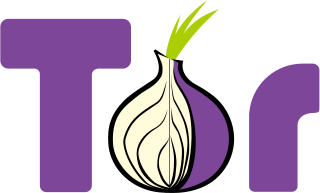Related Research Articles

Hyphanet is a peer-to-peer platform for censorship-resistant, anonymous communication. It uses a decentralized distributed data store to keep and deliver information, and has a suite of free software for publishing and communicating on the Web without fear of censorship. Both Freenet and some of its associated tools were originally designed by Ian Clarke, who defined Freenet's goal as providing freedom of speech on the Internet with strong anonymity protection.
Mixmaster is a Type II anonymous remailer which sends messages in fixed-size packets and reorders them, preventing anyone watching the messages go in and out of remailers from tracing them. It is an implementation of a David Chaum's mix network.
An anonymous remailer is a server that receives messages with embedded instructions on where to send them next, and that forwards them without revealing where they originally came from. There are cypherpunk anonymous remailers, mixmaster anonymous remailers, and nym servers, among others, which differ in how they work, in the policies they adopt, and in the type of attack on the anonymity of e-mail they can resist. Remailing as discussed in this article applies to e-mails intended for particular recipients, not the general public. Anonymity in the latter case is more easily addressed by using any of several methods of anonymous publication.

In computer networking, a proxy server is a server application that acts as an intermediary between a client requesting a resource and the server providing that resource. It improves privacy, security, and performance in the process.
A pseudonymous remailer or nym server, as opposed to an anonymous remailer, is an Internet software program designed to allow people to write pseudonymous messages on Usenet newsgroups and send pseudonymous email. Unlike purely anonymous remailers, it assigns its users a user name, and it keeps a database of instructions on how to return messages to the real user. These instructions usually involve the anonymous remailer network itself, thus protecting the true identity of the user.

David Lee Chaum is an American computer scientist, cryptographer, and inventor. He is known as a pioneer in cryptography and privacy-preserving technologies, and widely recognized as the inventor of digital cash. His 1982 dissertation "Computer Systems Established, Maintained, and Trusted by Mutually Suspicious Groups" is the first known proposal for a blockchain protocol. Complete with the code to implement the protocol, Chaum's dissertation proposed all but one element of the blockchain later detailed in the Bitcoin whitepaper. He has been referred to as "the father of online anonymity", and "the godfather of cryptocurrency".

Onion routing is a technique for anonymous communication over a computer network. In an onion network, messages are encapsulated in layers of encryption, analogous to the layers of an onion. The encrypted data is transmitted through a series of network nodes called "onion routers," each of which "peels" away a single layer, revealing the data's next destination. When the final layer is decrypted, the message arrives at its destination. The sender remains anonymous because each intermediary knows only the location of the immediately preceding and following nodes. While onion routing provides a high level of security and anonymity, there are methods to break the anonymity of this technique, such as timing analysis.
An anonymous P2P communication system is a peer-to-peer distributed application in which the nodes, which are used to share resources, or participants are anonymous or pseudonymous. Anonymity of participants is usually achieved by special routing overlay networks that hide the physical location of each node from other participants.
A dark net or darknet is an overlay network within the Internet that can only be accessed with specific software, configurations, or authorization, and often uses a unique customized communication protocol. Two typical darknet types are social networks, and anonymity proxy networks such as Tor via an anonymized series of connections.

Mixminion is the standard implementation of the Type III anonymous remailer protocol. Mixminion can send and receive anonymous e-mail.

Mix networks are routing protocols that create hard-to-trace communications by using a chain of proxy servers known as mixes which take in messages from multiple senders, shuffle them, and send them back out in random order to the next destination. This breaks the link between the source of the request and the destination, making it harder for eavesdroppers to trace end-to-end communications. Furthermore, mixes only know the node that it immediately received the message from, and the immediate destination to send the shuffled messages to, making the network resistant to malicious mix nodes.
Garlic routing is a variant of onion routing that encrypts multiple messages together to make it more difficult for attackers to perform traffic analysis and to increase the speed of data transfer.
An anonymizer or an anonymous proxy is a tool that attempts to make activity on the Internet untraceable. It is a proxy server computer that acts as an intermediary and privacy shield between a client computer and the rest of the Internet. It accesses the Internet on the user's behalf, protecting personal information of the user by hiding the client computer's identifying information such as IP addresses. Anonymous proxy is the opposite of transparent proxy, which sends user information in the connection request header. Commercial anonymous proxies are usually sold as VPN services.
In cryptography, the dining cryptographers problem studies how to perform a secure multi-party computation of the boolean-XOR function. David Chaum first proposed this problem in the early 1980s and used it as an illustrative example to show that it was possible to send anonymous messages with unconditional sender and recipient untraceability. Anonymous communication networks based on this problem are often referred to as DC-nets.

Tor is a free overlay network for enabling anonymous communication. Built on free and open-source software and more than seven thousand volunteer-operated relays worldwide, users can have their Internet traffic routed via a random path through the network.
Zerocoin is a privacy protocol proposed in 2013 by Johns Hopkins University professor Matthew D. Green and his graduate students, Ian Miers and Christina Garman. It was designed as an extension to the Bitcoin protocol that would improve Bitcoin transactions' anonymity by having coin-mixing capabilities natively built into the protocol. Zerocoin is not currently compatible with Bitcoin.

Ricochet or Ricochet IM is a free software, multi-platform, instant messaging software project originally developed by John Brooks and later adopted as the official instant messaging client project of the Invisible.im group. A goal of the Invisible.im group is to help people maintain privacy by developing a "metadata free" instant messaging client.

Roger Dingledine is an American computer scientist known for having co-founded the Tor Project. A student of mathematics, computer science, and electrical engineering, Dingledine is also known by the pseudonym arma. As of December 2016, he continues in a leadership role with the Tor Project, as a project Leader, Director, and Research Director.

Firo, formerly known as Zcoin, is a cryptocurrency aimed at using cryptography to provide better privacy for its users compared to other cryptocurrencies such as Bitcoin.
A wireless onion router is a router that uses Tor to connect securely to a network. The onion router allows the user to connect to the internet anonymously creating an anonymous connection. Tor works using an overlaid network which is free throughout the world, this overlay network is created by using numerous relay points created using volunteer which helps the user hide personal information behind layers of encrypted data like layers of an onion. Routers are being created using Raspberry Pi adding a wireless module or using its own inbuilt wireless module in the later versions.
References
- ↑ Uchill, Joe (2016-07-11). "Researchers tout new anonymity network". TheHill. Retrieved 2021-02-12.
- ↑ Francisco, Iain Thomson in San. "Meet Riffle, the next-gen anonymity network that hopes to trounce Tor". www.theregister.com. Retrieved 2021-02-12.
- ↑ Larry Hardesty (11 July 2016). "How to stay anonymous online". MIT News.
- 1 2 3 4 Kwon, Albert; Lazar, David; Devadas, Srinivas; Ford, Bryan (1 April 2016). "Riffle: An Efficient Communication System With Strong Anonymity" (PDF). Proceedings on Privacy Enhancing Technologies. 2: 115–134. doi: 10.1515/popets-2016-0008 . hdl:1721.1/128773.
- ↑ "Building a new Tor that can resist next-generation state surveillance". Ars Technica. 2016-08-31. Retrieved 2021-02-12.